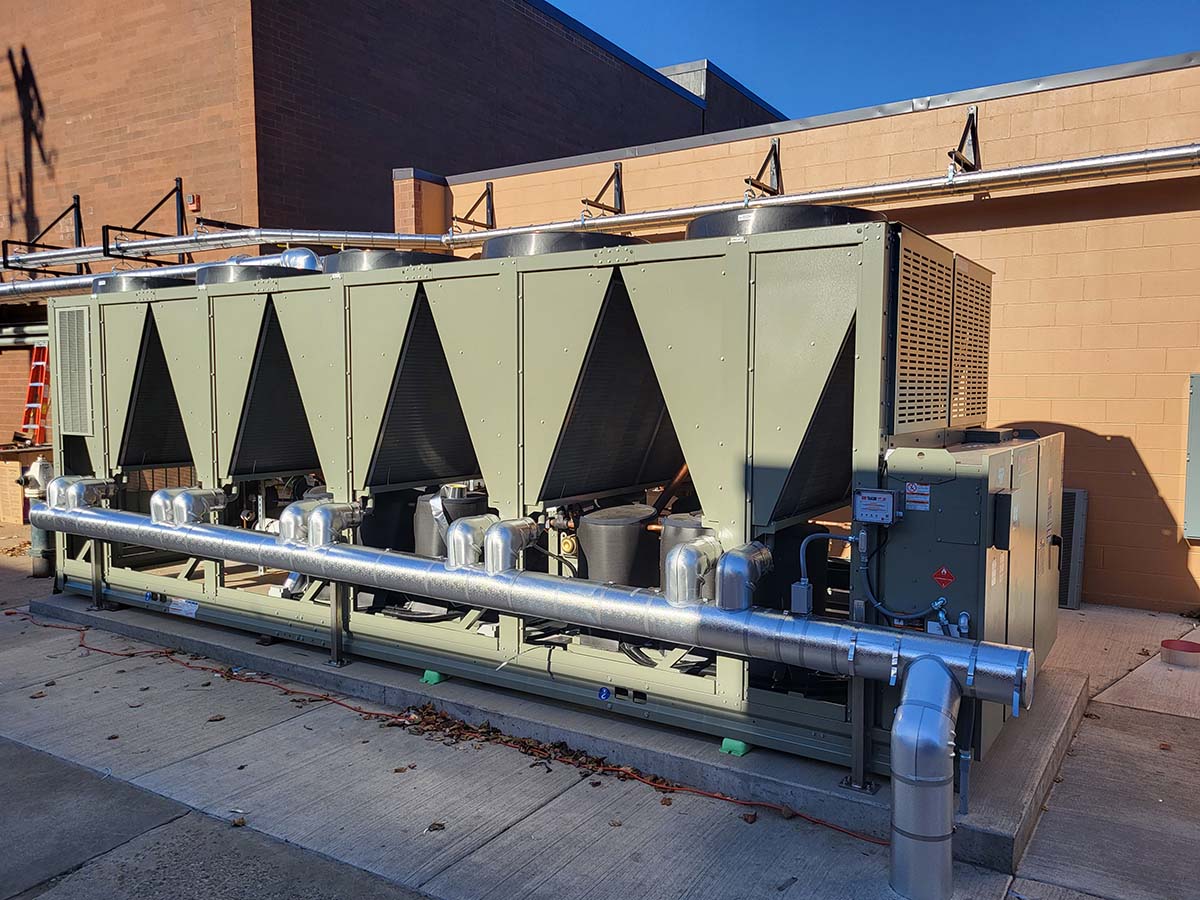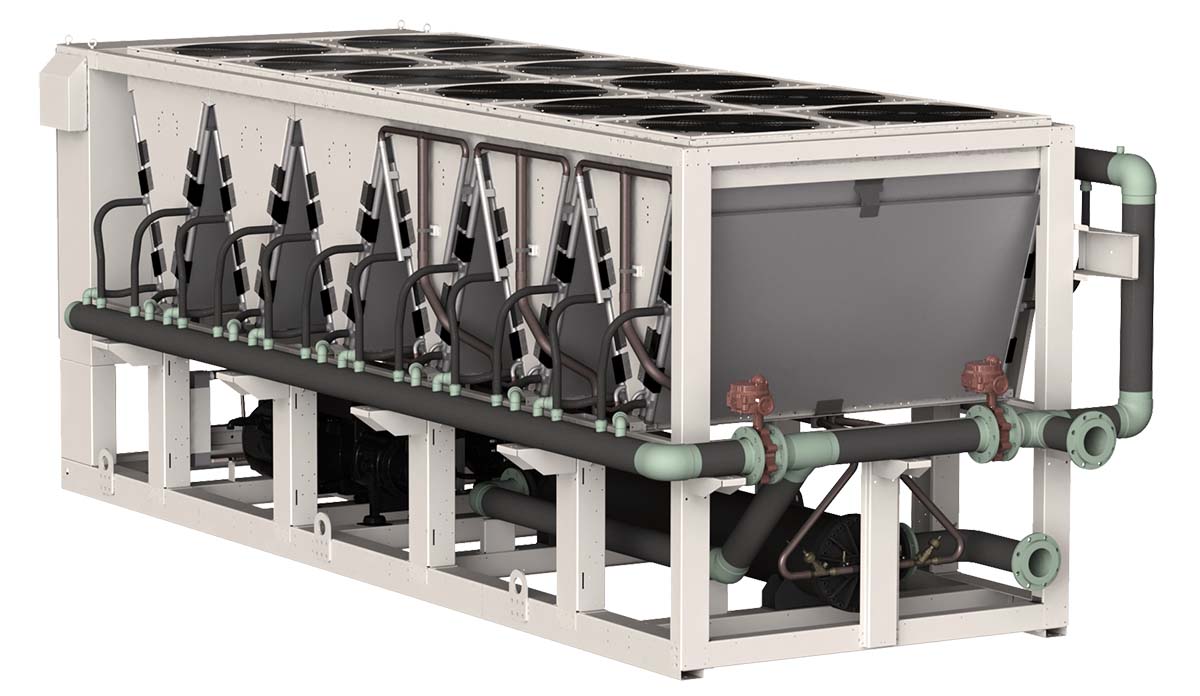HVAC systems development engineer,
Trane Commercial HVAC
Today’s chillers offer a wealth of opportunities and also pose some challenges for manufacturers, installers, and end users.
Chillers can be used as heat pumps to provide efficient heating as well as cooling, outfitted with heat-recovery systems to harness rejected heat, used in building electrification projects, and installed in massive arrays to cool the data centers springing up around the country that are at the heart of the internet-dependent information economy.
These types of applications, when they meet real-world challenges such as sustainability goals, water scarcity in some regions, high ambient temperatures, and regulations that limit the availability of high-GWP refrigerants, are prompting manufacturers to come up with creative solutions in deploying chiller technology.
Chiller as a Heat Pump
“Chillers today can do more than cool spaces,” said Rick Heiden, HVAC systems development engineer at Trane Commercial HVAC. “Many models can be configured with heat pumps and heat recovery to also provide heating. Electrification of heating is part of the trend to decarbonize building HVAC systems.”
Trane, Heiden said, is using one of its models as part of a new chiller-heat pump system at a company training facility in LaCrosse, Wisconsin.
The Ascend ACX, he said, is an air-cooled chiller outfitted with a reversing valve that allows it to both cool and heat. The air-to-water model in LaCrosse will be used to extract heat from outside air as cold as 0°F, Heiden said, and put it into thermal energy storage tanks. The new system, expected to become fully operational this August, will also rely on a super-low-ambient heat pump to find heat in even colder outdoor air (down to -20°F), two heat pumps to access the heat in the thermal tanks, and three electric boilers in case backup heat is needed.

VERSATILITY: Trane’s Ascend ACX is an air-cooled chiller outfitted with a reversing valve that allows it to also provide heating. The Ascend ACX is part of a project to electrify both the heating and cooling at a company training facility in LaCrosse, Wisconsin. (Courtesy of Trane Commercial HVAC)
Heiden said the system is being installed to demonstrate how an all-electric heating and cooling system can use thermal energy storage in a cold climate during extended periods of below-zero temperatures.
“The flexibility of chiller-heat pump systems enables building owners to craft a solution based on their budget, needs, and goals,” he said. “Each building that achieves electrification of heat helps society as a whole take positive steps to address climate change challenges.”
Electrification and Efficiency
The heat-pump function on a new York CYK chiller model from Johnson Controls is at the center of a just-announced project to electrify the Ronald Reagan Building and International Trade Center (RRBITC) in Washington, D.C. Owned by the federal government, the RRBITC is occupied by several government agencies and private entities, all of which are in some way involved in international trade and international relations.
The York CYK chiller will provide RRBITC with up to about 449 tons of cooling and also act as a heat pump, yielding up to 7.4 million Btus of heating “with a combined cooling and heating CoP (coefficient of performance) of 5.14,” said Rajesh Dixit, director of global HVACR product management in the building technologies division at Johnson Controls.
“So, extremely efficient,” Dixit added. “We’re doing this with the ultra-low-GWP refrigerant R-1234ze.”
The water-cooled York CYK, which uses two single-stage compressors, will provide chilled water at 44°F and hot water at up to 170°F, Dixit said.
The project will also employ supplemental electric boilers, and is intended to shift the RRBITC from the natural-gas-fired district stream plant that currently heats it. Electrifying the RRBITC is expected to prevent 2,242 metric tons of greenhouse gas emissions annually and lead to energy savings of 8.7%, according to a press release from Johnson Controls.
The company announced the electrification project last month, after the U.S. General Services Administration (GSA), which manages the building, was given funding for it. The RRBITC will be the first fully electrified federal building in the nation’s capital.
Air-Cooled Chillers
Data centers in warmer, drier parts of the U.S., such as the Southwest, pose special challenges for their owners and for chiller engineers and manufacturers, said Hugh Hudson, data center solutions and sales director at Daikin Applied.
Companies that put data centers in these regions, Hudson said, typically do so because those areas are growing, tend to have favorable business climates, and are closer to some of the big data consumers that need access to them. But higher outdoor temperatures and, in some places, the scarcity of water for water-cooled chillers are significant obstacles.
Data centers require constant cooling in order to protect expensive equipment that generates a lot of heat, and therefore exhaust large amounts of heat. One large multi-tenant data center building might have 30 or more chillers, each with a capacity of up to 500 tons, adding up to 100 or more chillers on a data center campus with three buildings, Hudson said.

HEAVY-DUTY COOLING: A Daikin Pathfinder air-cooled screw chiller, which the company says is designed for cooling data centers and other energy-intense applications. (Courtesy of Daikin Applied)
Many new data centers are installing air-cooled chillers, something Daikin Applied noticed years ago, because of concerns over water usage, Hudson said.
“We’ve been seeing a huge trend toward air-cooled chillers for that reason,” he said.
The trend, however, poses another challenge when 30 or more chillers arranged on a rooftop are both rejecting heat to the air and also taking in air for the cooling process, Hudson said. On top of that, higher ambient temperatures in the Southwest, even without the chiller exhaust, complicate the picture, he said.
“What you want to do is have your chiller more robust to operate at higher ambiance,” he said. In Phoenix, Arizona, he said, that can be as high as nearly 120°F.
“You never want to starve the chiller” of air, said Hudson, but in order to prevent data-center chillers from taking in heated air they’ve just rejected, designers are using a canopy system that separates the exhaust from the air intake. “You’re basically blocking chiller to chiller, so the air doesn’t come back around into it,” he said.
In addition, chillers are also being put on raised, grated rooftop platforms to increase the amount of cooler air circulating around them.
“We can also do chillers with adiabatic assist on them ... to drop the temperature a little more going into the coil,” Hudson said.
Harnessing Waste Heat
Chiller experts are increasingly looking at ways to use rejected heat for space heating and domestic hot water needs as well as for process heating.
“Heat-recovery chillers use existing heat that would otherwise be wasted in the cooling process,” Heiden said, at Trane Commercial HVAC. “To be beneficial, they require a simultaneous demand for cooling and heating, but they are one of the most efficient forms of heating available.”
“The consumer of that heat could probably have a lower utility bill, and it could be a win-win,” said Daikin Applied’s Hudson.
It can be challenging, though, to match a facility with big cooling needs with an operation that can consistently use that rejected heat. But pairing a data center with a large consumer of heat, Hudson said, is more a business problem than a technical problem.
Hudson mentioned an indoor farming operation in Wyoming that’s co-located with a data center and uses its rejected heat, but even a greenhouse doesn’t need that kind of heat year ’round, he said.
“There’re a lot of people thinking about how you can extract that heat, harvest that heat, and use it for other purposes,” said Hudson.



Report Abusive Comment